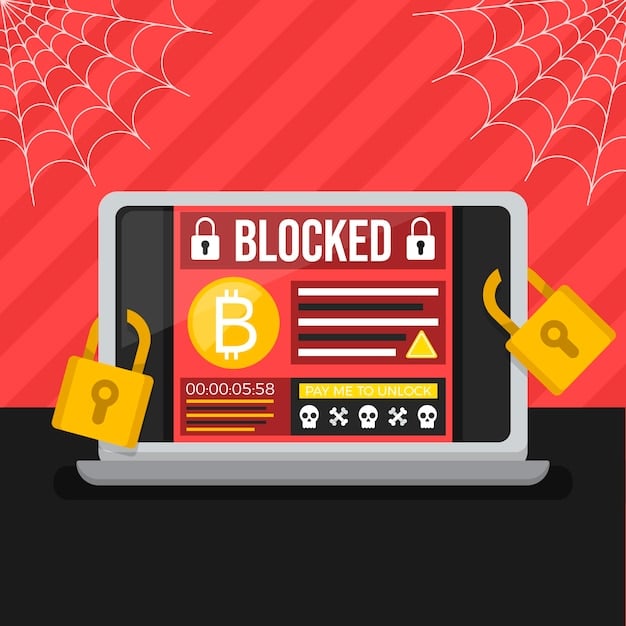Bitcoin Security: Protecting Your Wallet from Phishing Attacks in the US

Securing your Bitcoin wallet from phishing attacks is crucial, especially for US users, involving vigilance against deceptive emails, websites, and messages designed to steal your private keys or sensitive information; implementing strong security practices is essential to safeguard your digital assets.
The rise of Bitcoin and other cryptocurrencies has brought exciting opportunities, but it has also attracted malicious actors. For US users, understanding and implementing robust Bitcoin security measures is paramount, especially when it comes to protecting your wallet from phishing attacks. These attacks aim to trick you into revealing your private keys or other sensitive information, leading to potential loss of funds. Let’s delve into how you can fortify your defenses.
Understanding the Threat: Bitcoin Phishing Attacks
Phishing attacks are a persistent threat in the digital world, and Bitcoin users are no exception. These attacks rely on deception, aiming to trick individuals into divulging sensitive information. Understanding how these attacks work is the first step in protecting your Bitcoin wallet.
Common Phishing Tactics
Phishers employ various methods to deceive their victims. Here are some common tactics:
- Fake Websites: Creating websites that mimic legitimate Bitcoin exchanges or wallet providers.
- Deceptive Emails: Sending emails that appear to be from trusted sources, such as Coinbase or Binance, requesting login details or account verification.
- Social Media Scams: Spreading fake promotions or giveaways on social media platforms to lure users into clicking malicious links.
Why US Users Are Targeted
US users are often targeted due to the country’s significant Bitcoin adoption rate and relatively high wealth. This makes them a lucrative target for cybercriminals seeking to steal digital assets.
Phishing attacks are constantly evolving, so staying informed about the latest tactics is essential. By understanding how these attacks work, you can better protect yourself from falling victim to them.

Recognizing the motives and methods behind phishing is your first defense. Staying skeptical and informed can significantly reduce your risk of being victimized.
Strengthening Your Bitcoin Wallet Security
Securing your Bitcoin wallet involves a multi-faceted approach. Strong passwords, two-factor authentication, and hardware wallets are essential components of a robust security strategy. By implementing these measures, you can significantly reduce the risk of unauthorized access to your funds.
Strong Passwords and Two-Factor Authentication (2FA)
Using strong, unique passwords for your Bitcoin wallet and related accounts is crucial. Additionally, enabling 2FA adds an extra layer of security, requiring a second verification method, such as a code sent to your phone, before access is granted.
Hardware Wallets
Hardware wallets are physical devices that store your private keys offline, making them immune to online threats. They are considered one of the most secure ways to store Bitcoin.
- Offline Storage: Keeps your private keys away from potential online attacks.
- Physical Confirmation: Requires physical confirmation of transactions, adding an extra layer of security.
- Compatibility: Works with various software wallets for easy management of your Bitcoin.
Combining strong passwords, 2FA, and a hardware wallet provides a formidable defense against phishing and other security threats.
Your digital assets require diligent protection, and these security measures serve as a strong foundation for safeguarding your Bitcoin holdings.
Identifying and Avoiding Phishing Emails
Phishing emails are one of the most common methods used by cybercriminals to target Bitcoin users. Learning to identify these deceptive emails is essential for protecting your Bitcoin wallet.
Red Flags in Phishing Emails
There are several telltale signs that can help you identify phishing emails:
- Poor Grammar and Spelling: Phishing emails often contain grammatical errors and misspellings.
- Suspicious Links: Be wary of links that don’t match the website’s official domain or use URL shorteners.
- Urgent Requests: Phishers often create a sense of urgency, pressuring you to act quickly.
- Generic Greetings: Emails that start with generic greetings like “Dear Customer” are often suspicious.
Verifying Email Authenticity
Always verify the authenticity of an email before clicking on any links or providing any information. Check the sender’s email address carefully and contact the organization directly if you have any doubts.
Staying vigilant and practicing caution when dealing with suspicious emails can help you avoid falling victim to phishing attacks.
By recognizing the red flags and taking proactive steps to verify email authenticity, you can significantly reduce your risk of being deceived.

Securing Your Online Accounts
Protecting your online accounts is crucial for maintaining Bitcoin security. Compromised email or social media accounts can be used to launch phishing attacks or gain access to your Bitcoin wallet.
Best Practices for Account Security
Follow these best practices to secure your online accounts:
- Use Strong, Unique Passwords: Create strong passwords that are difficult to guess and use a different password for each account.
- Enable Two-Factor Authentication (2FA): Enable 2FA on all accounts that support it, adding an extra layer of security.
- Regularly Update Your Software: Keep your operating system, web browser, and security software up to date with the latest patches.
Monitoring Account Activity
Regularly monitor your account activity for any suspicious behavior. Set up alerts for unusual logins or transactions.
Securing your online accounts is a critical component of overall Bitcoin security. By following these best practices and staying vigilant, you can minimize the risk of account compromise.
Your online accounts act as gateways to your digital identity; securing them is paramount in fortifying your Bitcoin defenses.
Utilizing Security Tools and Software
Various security tools and software can help protect your Bitcoin wallet from phishing attacks and other threats. These tools can provide an extra layer of security and help you stay informed about potential risks.
Antivirus and Anti-Malware Software
Install and regularly update antivirus and anti-malware software on your computer and mobile devices. These programs can detect and remove malicious software that could be used to steal your Bitcoin.
Password Managers
Use a password manager to securely store and generate strong, unique passwords for your accounts. Password managers can also help you identify phishing websites.
Browser Extensions for Security
Consider using browser extensions that block phishing websites and warn you about potentially malicious links.
Leveraging security tools and software can significantly enhance your Bitcoin protection strategy. These tools can help you stay safe online and prevent phishing attacks from compromising your wallet.
In the ever-evolving landscape of cybersecurity, these tools act as vigilant allies, safeguarding your Bitcoin assets.
Staying Informed and Educated
The world of Bitcoin and cryptocurrency security is constantly evolving. Staying informed about the latest threats and best practices is crucial for protecting your Bitcoin wallet. Resources like following security experts, participating in community forums, and keeping up with industry news.
Following Security Experts
Follow reputable security experts on social media and subscribe to their newsletters to stay informed about the latest threats and vulnerabilities.
- Twitter: Follow security experts and cryptocurrency influencers.
- Blogs: Read cybersecurity blogs and Bitcoin-specific security resources.
- Newsletters: Subscribe to newsletters from reputable security firms and cryptocurrency news outlets.
Participating in Community Forums
Engage in community forums and online discussions to learn from other Bitcoin users and share your own experiences.
Staying informed and educated is an ongoing process. By actively seeking out information and engaging with the community, you can enhance your Bitcoin security and protect your wallet from phishing attacks.
Continuous learning is vital in the dynamic world of cybersecurity, empowering you to anticipate and mitigate emerging threats.
Responding to a Phishing Attack
Even with the best security measures, you might still fall victim to a phishing attack. Knowing how to respond quickly and effectively can minimize the damage and prevent further loss of funds.
Immediate Actions to Take
If you suspect you’ve been targeted by a phishing attack, take these immediate actions:
- Change Your Passwords: Immediately change your passwords for your Bitcoin wallet and related accounts.
- Report the Attack: Report the phishing attack to the relevant authorities, such as the FTC in the US.
- Contact Your Wallet Provider: If you suspect your wallet has been compromised, contact your wallet provider immediately.
Preventative Measures After an Attack
After a phishing attack, take these preventative measures to protect yourself in the future:
Acting quickly and decisively after a phishing attack is crucial for minimizing the damage and protecting your Bitcoin wallet. By taking the right steps, you can mitigate the impact of the attack and prevent further loss of funds.
Remember, your response to a phishing attack can be the deciding factor in minimizing losses and maintaining your digital security.
| Key Element | Brief Description |
|---|---|
| 🎣 Identify Phishing | Recognize red flags like poor grammar and suspicious links. |
| 🔒 Secure Accounts | Use strong passwords and enable 2FA on all accounts. |
| 🛡️ Security Tools | Employ antivirus software and password managers. |
| 📚 Stay Informed | Follow security experts and participate in community forums. |
Frequently Asked Questions
▼
A Bitcoin phishing attack is a deceptive attempt to steal your private keys or other sensitive information by disguising as a trustworthy entity. These attacks often involve fake emails or websites.
▼
Look for red flags like poor grammar, suspicious links, urgent requests for information, and generic greetings. Always verify the sender’s email address and contact the organization directly if uncertain.
▼
2FA adds an extra layer of security by requiring a second verification method, such as a code sent to your phone, before access is granted. This makes it harder for attackers to compromise your account.
▼
A hardware wallet is a physical device that stores your private keys offline, making them immune to online threats. It requires physical confirmation of transactions, adding an extra layer of security.
▼
Immediately change your passwords for your Bitcoin wallet and related accounts. Report the phishing attack to the relevant authorities and contact your wallet provider for assistance.
Conclusion
Protecting your Bitcoin wallet from phishing attacks requires a vigilant and proactive approach. By understanding the threats, implementing strong security measures, and staying informed about the latest tactics, US users can significantly reduce their risk and safeguard their digital assets. Remember that security is an ongoing process, and vigilance is key.





